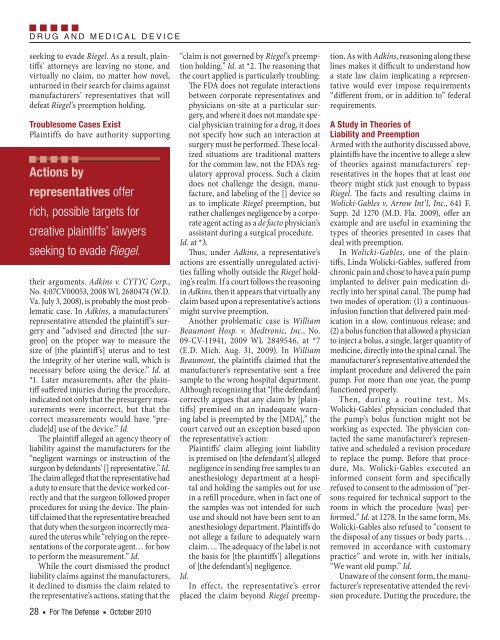For The Defense, October 2010 - DRI Today
For The Defense, October 2010 - DRI Today
For The Defense, October 2010 - DRI Today
Create successful ePaper yourself
Turn your PDF publications into a flip-book with our unique Google optimized e-Paper software.
D R U G A N D M E D I C A L D E V I C Eseeking to evade Riegel. As a result, plaintiffs’attorneys are leaving no stone, andvirtually no claim, no matter how novel,unturned in their search for claims againstmanufacturers’ representatives that willdefeat Riegel’s preemption holding.Troublesome Cases ExistPlaintiffs do have authority supportingActions byrepresentatives offerrich, possible targets forcreative plaintiffs’ lawyersseeking to evade Riegel.their arguments. Adkins v. CYTYC Corp.,No. 4:07CV00053, 2008 WL 2680474 (W.D.Va. July 3, 2008), is probably the most problematiccase. In Adkins, a manufacturers’representative attended the plaintiff’s surgeryand “advised and directed [the surgeon]on the proper way to measure thesize of [the plaintiff’s] uterus and to testthe integrity of her uterine wall, which isnecessary before using the device.” Id. at*1. Later measurements, after the plaintiffsuffered injuries during the procedure,indicated not only that the presurgery measurementswere incorrect, but that thecorrect measurements would have “preclude[d]use of the device.” Id.<strong>The</strong> plaintiff alleged an agency theory ofliability against the manufacturers for the“negligent warnings or instruction of thesurgeon by defendants’ [] representative.” Id.<strong>The</strong> claim alleged that the representative hada duty to ensure that the device worked correctlyand that the surgeon followed properprocedures for using the device. <strong>The</strong> plaintiffclaimed that the representative breachedthat duty when the surgeon incorrectly measuredthe uterus while “relying on the representationsof the corporate agent… for howto perform the measurement.” Id.While the court dismissed the productliability claims against the manufacturers,it declined to dismiss the claim related tothe representative’s actions, stating that the28 n <strong>For</strong> <strong>The</strong> <strong>Defense</strong> n <strong>October</strong> <strong>2010</strong>“claim is not governed by Riegel’s preemptionholding.” Id. at *2. <strong>The</strong> reasoning thatthe court applied is particularly troubling:<strong>The</strong> FDA does not regulate interactionsbetween corporate representatives andphysicians on-site at a particular surgery,and where it does not mandate specialphysician training for a drug, it doesnot specify how such an interaction atsurgery must be performed. <strong>The</strong>se localizedsituations are traditional mattersfor the common law, not the FDA’s regulatoryapproval process. Such a claimdoes not challenge the design, manufacture,and labeling of the [] device soas to implicate Riegel preemption, butrather challenges negligence by a corporateagent acting as a de facto physician’sassistant during a surgical procedure.Id. at *3.Thus, under Adkins, a representative’sactions are essentially unregulated activitiesfalling wholly outside the Riegel holding’srealm. If a court follows the reasoningin Adkins, then it appears that virtually anyclaim based upon a representative’s actionsmight survive preemption.Another problematic case is WilliamBeaumont Hosp. v. Medtronic, Inc., No.09-CV-11941, 2009 WL 2849546, at *7(E.D. Mich. Aug. 31, 2009). In WilliamBeaumont, the plaintiffs claimed that themanufacturer’s representative sent a freesample to the wrong hospital department.Although recognizing that “[the defendant]correctly argues that any claim by [plaintiffs]premised on an inadequate warninglabel is preempted by the [MDA],” thecourt carved out an exception based uponthe representative’s action:Plaintiffs’ claim alleging joint liabilityis premised on [the defendant’s] allegednegligence in sending free samples to ananesthesiology department at a hospitaland holding the samples out for usein a refill procedure, when in fact one ofthe samples was not intended for suchuse and should not have been sent to ananesthesiology department. Plaintiffs donot allege a failure to adequately warnclaim…. <strong>The</strong> adequacy of the label is notthe basis for [the plaintiffs’] allegationsof [the defendant’s] negligence.Id.In effect, the representative’s errorplaced the claim beyond Riegel preemption.As with Adkins, reasoning along theselines makes it difficult to understand howa state law claim implicating a representativewould ever impose requirements“different from, or in addition to” federalrequirements.A Study in <strong>The</strong>ories ofLiability and PreemptionArmed with the authority discussed above,plaintiffs have the incentive to allege a slewof theories against manufacturers’ representativesin the hopes that at least onetheory might stick just enough to bypassRiegel. <strong>The</strong> facts and resulting claims inWolicki- Gables v. Arrow Int’l, Inc., 641 F.Supp. 2d 1270 (M.D. Fla. 2009), offer anexample and are useful in examining thetypes of theories presented in cases thatdeal with preemption.In Wolicki- Gables, one of the plaintiffs,Linda Wolicki- Gables, suffered fromchronic pain and chose to have a pain pumpimplanted to deliver pain medication directlyinto her spinal canal. <strong>The</strong> pump hadtwo modes of operation: (1) a continuousinfusionfunction that delivered pain medicationin a slow, continuous release; and(2) a bolus function that allowed a physicianto inject a bolus, a single, larger quantity ofmedicine, directly into the spinal canal. <strong>The</strong>manufacturer’s representative attended theimplant procedure and delivered the painpump. <strong>For</strong> more than one year, the pumpfunctioned properly.<strong>The</strong>n, during a routine test, Ms.Wolicki- Gables’ physician concluded thatthe pump’s bolus function might not beworking as expected. <strong>The</strong> physician contactedthe same manufacturer’s representativeand scheduled a revision procedureto replace the pump. Before that procedure,Ms. Wolicki- Gables executed aninformed consent form and specificallyrefused to consent to the admission of “personsrequired for technical support to theroom in which the procedure [was] performed.”Id. at 1278. In the same form, Ms.Wolicki- Gables also refused to “consent tothe disposal of any tissues or body parts…removed in accordance with customarypractice” and wrote in, with her initials,“We want old pump.” Id.Unaware of the consent form, the manufacturer’srepresentative attended the revisionprocedure. During the procedure, the
















